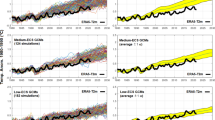Abstract
Recent work in modelling climatic changes due to increased atmospheric CO2 has shown the maximum change to occur in the polar regions as a result of seasonal reductions in sea ice coverage. Typically, sea ice thermodynamics is modelled in a very simple way, whereby the storage of both sensible and latent heat within the ice is ignored, and the effects of snow cover on conductivity and on surface albedo and of oceanic heat flux on bottom ablation may also be neglected. This paper considers whether omission of these processes is justified within the context of quantitatively determining regional climatic changes. A related question, whether omission of ice dynamics can be justified, is not considered.
Relatively complete one-dimensional models of sea-ice thermodynamics have previously been developed and tested for a variety of environmental conditions by Maykut and Untersteiner (1969, 1971) and by Semtner (1976). A simpler model which neglects the storage of sensible and latent heat is described in the Appendix to Semtner (1976). In that model, the errors in annual-mean ice thickness which would arise from neglect of heat storage can be compensated by increases in albedo and in conductivity. Here we examine the seasonal cycle of ice thickness predicted by such a model and find significant errors in phase (one month lead) and in amplitude (≈50% overestimate). The amplitude errors are enhanced as snowfall and oceanic heat flux diminish (or are neglected). This suggests that substantial errors may occur in climate simulations which use very simple formulations of sea ice thermodynamics, whereby early and excessive melting exaggerates the seasonal disappearance of sea ice.
To illustrate the above point, two models are configured to examine the local response of Arctic sea ice to a quadrupling of atmospheric CO2. The first model neglects a number of physical processes and mimics the behavior of sea ice found in Manabe and Stouffer (1980), both for present and enhanced levels of CO2. The more complete second model gives a better simulation of Arctic ice for the present level of CO2 and shows a reduced response to CO2 quadrupling relative to that in Manabe and Stouffer (1980). In particular, the change in surface temperature is cut by a factor of two. In view of this result, a more complete treatment of sea ice thermodynamics would seem warranted in further studies of climate change. Only a minor computational increase is required.
Similar content being viewed by others
References
Fletcher, J. O.: 1965, ‘The Heat Budget of the Arctic Basin and its Relation to Climate’, Memo R-444-PR, Rand Corp., Santa Monica, Calif., 179 pp.
Hibler, W. D., III: 1979, ‘A Dynamic Thermodynamic Sea Ice Model’, J. Phys. Oceanogr. 9, 815–846.
Hibler, W. D., III and Bryan, K.: 1984, ‘On Modelling Ocean Circulation in Seasonal Sea Ice Simulations’, (in preparation).
Manabe, S. and Stouffer, R. J.: 1980, ‘Sensitivity of a Global Climate Model to an Increase of CO2 Concentration in the Atmosphere’, J. Geophys. Res. 85, 5528–5554.
Maykut, G. A. and Untersteiner, N.: 1969, ‘Numerical Prediction of the Thermodynamic Response of Arctic Sea Ice to Environmental Changes’, Memo RM-6093-PR, Rand Corp., Santa Monica, Calif., 173 pp.
Maykut, G. A. and Untersteiner, N.: 1971, ‘Some Results from a Time-dependent Thermodynamic Model of Sea Ice’, J. Geophys. Res. 76, 1550–1575.
Parkinson, C. L. and Kellogg, W. W.: 1979, ‘Arctic Sea ice Decay Simulated for a CO2-induced Temperature Rise’, Climatic Change 2, 149–162.
Parkinson, C. L. and Washington, W. M.: 1979, ‘A Large-scale Numerical Model of Sea Ice’, J. Geophys. Res. 84, 311–337.
Ramanathan, V.: 1981, ‘The Role of Ocean-atmosphere Interactions in the CO2 Climate Problem’, J. Atmos. Sci. 38, 918–930.
Schlesinger, M. E.: 1982, ‘CO2-Induced Climatic Warming - A Review of Model Research and Prospectus for First Detectability’, Report No. 36, Climatic Research Institute, Oregon State University, Corvallis, 25 pp.
Semtner, A. J.: 1976, ‘A Model for the Thermodynamic Growth of Sea Ice in Numerical Investigations of Climate’, J. Phys. Oceanogr. 6, 379–389.
Shine, K. P. and Henderson-Sellers, A.: 1984, ‘The Sensitivity of a Thermodynamic Ice Model to Changes in Surface Albedo Parameterization’, J. Geophys. Res. (submitted).
Thorndike, A. S. and Colony, R.: 1982, ‘Sea Ice Motion in Response to Geostrophic Winds’, J. Geophys. Res. 87, 5845–5852.
Washington, W. M. and Meehl, G. A.: 1983, ‘Seasonal Cycle Experiments on the Climate Sensitivity Due to a Doubling of CO2 with an Atmospheric General Circulation Model Coupled to a Simple Mixed Layer Ocean Model’, J. Geophys. Res. (submitted).
Washington, W. M., Semtner, A. J., Parkinson, C., and Morrison, L.: 1976, ‘On the Development of a Seasonal Change Sea-Ice Model’, J. Phys. Oceanogr. 6, 679–685.
Zwally, H. J.: 1984, ‘Observing Polar Ice Variability’, Annals of Glaciology 5 (in press).
Author information
Authors and Affiliations
Additional information
A portion of this study is supported by the U.S. Department of Energy as a part of its Carbon Dioxide Research Program.
The National Center for Atmospheric Research is sponsored by the National Science Foundation.
Rights and permissions
About this article
Cite this article
Semtner, A.J. On modelling the seasonal thermodynamic cycle of sea ice in studies of climatic change. Climatic Change 6, 27–37 (1984). https://doi.org/10.1007/BF00141666
Received:
Revised:
Issue Date:
DOI: https://doi.org/10.1007/BF00141666




